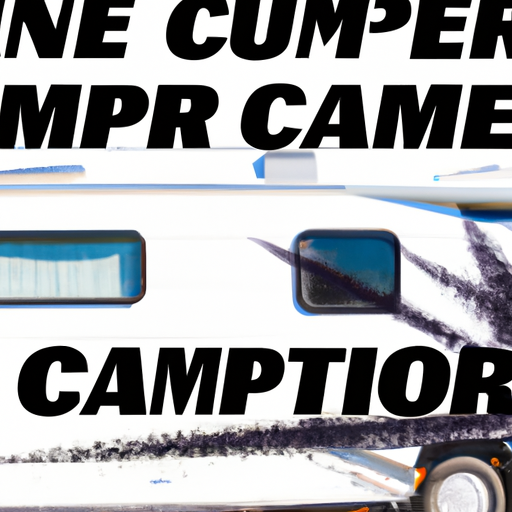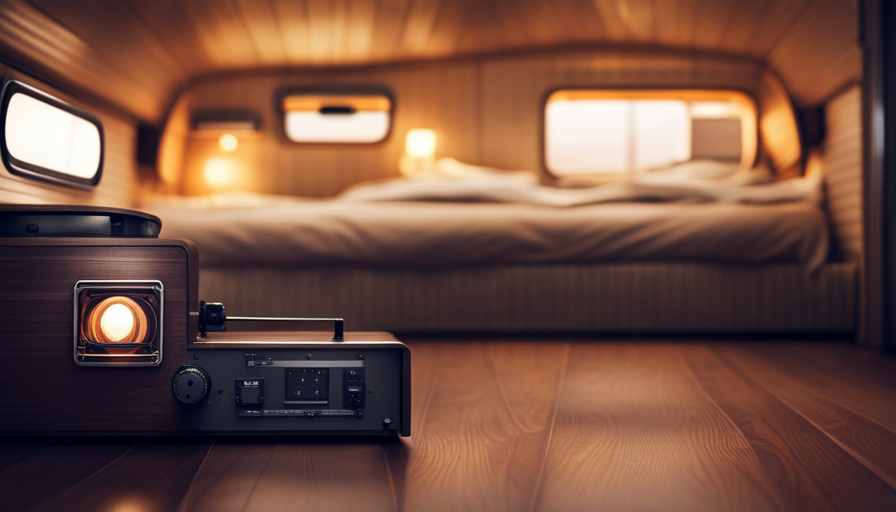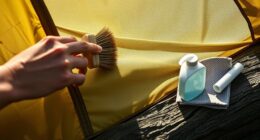Fed up with the unattractive black marks ruining the smooth surface of your cherished camper? Don’t worry, fellow explorers, because we’ve got the perfect solution for you! In this enlightening and comprehensive article, we’re going to unveil the ultimate trick to get rid of those annoying black streaks that have been blemishing your beloved vehicle.
But before we dive into the nitty-gritty of this magical remedy, let’s take a moment to appreciate the sheer audacity of these streaks. Oh, how they mock us with their stubbornness, daring us to find a solution! Well, my friends, it’s time to show them who’s boss.
Armed with a few simple supplies and a touch of determination, we will guide you through the process of banishing those black streaks for good. From homemade remedies to commercial cleaning products, we’ll explore all the options available to you.
So, buckle up and get ready to restore your camper’s pristine shine, because we’re about to embark on a cleaning adventure like no other!
Key Takeaways
- Regular maintenance and washing with a mild detergent and soft brush can help prevent black streaks on campers.
- Applying a protective wax coating can repel dirt and make it easier to remove black streaks from campers.
- Homemade remedies like vinegar and water or baking soda paste can be effective in removing black streaks from campers.
- Specialized cleaners designed for campers are highly effective at removing black streaks and should be used according to the manufacturer’s instructions.
Understand the Cause of Black Streaks
To understand the cause of those pesky black streaks on your camper, you’ll need to take a closer look at the environmental factors that contribute to their formation. Black streaks are typically a combination of dirt, grime, and oxidation that accumulate on the surface of your camper over time. When it rains or when there’s condensation, these substances mix with water and flow down the sides of your camper, leaving behind those unsightly streaks.
Prevention is key when it comes to dealing with black streaks. Regular maintenance is essential to keep your camper in top shape. Here are a few tips to help you prevent black streaks from appearing in the first place. Firstly, make sure to wash your camper frequently, especially after a trip or when it’s been exposed to dirt or pollutants. Use a mild detergent and a soft brush to gently scrub away any dirt or grime. Additionally, applying a protective wax coating can help repel dirt and make it easier to remove black streaks in the future.
Now that you understand the cause of black streaks and have a few prevention and maintenance tips under your belt, it’s time to gather the necessary supplies for removing those stubborn marks.
Gather the Necessary Supplies
Gather up all the supplies you’ll need to make your camper shine like new again. Preparing the necessary supplies is crucial to effectively remove black streaks from your camper.
Start by gathering a bucket, mild detergent, soft-bristle brush, microfiber cloths, and a ladder if needed. The bucket will be used to mix the detergent with water for cleaning. Choose a mild detergent to avoid damaging the camper’s surface. A soft-bristle brush is ideal for scrubbing away the black streaks without scratching the material. Microfiber cloths are perfect for drying and polishing the surface after cleaning. If you plan on cleaning hard-to-reach areas, a ladder will come in handy.
To ensure a successful cleaning process, it’s important to familiarize yourself with effective techniques. Begin by filling the bucket with warm water and adding the mild detergent according to the manufacturer’s instructions. Dip the soft-bristle brush into the soapy water and gently scrub the black streaks, working from top to bottom. Rinse the brush frequently to prevent spreading dirt and grime. Once the black streaks are removed, use the microfiber cloths to dry and polish the surface, leaving it looking shiny and clean.
With all the necessary supplies gathered and effective techniques in mind, you’re now ready to move on to preparing the surface for cleaning.
Preparing the Surface
First, take a moment to assess the surface of your camper and consider the potential for a fresh start. Surface preparation techniques are crucial in ensuring effective removal of black streaks. To achieve this, it’s important to use proper cleaning methods. Here are four key factors to consider:
-
Use a gentle cleaning solution: Harsh chemicals can damage the surface of your camper. Opt for a mild soap or specialized camper cleaner to avoid any unwanted damage.
-
Scrub with a soft brush: A soft-bristled brush will help remove the black streaks without causing scratches. Gently scrub the affected areas to loosen the dirt and grime.
-
Rinse thoroughly: After scrubbing, make sure to rinse the surface thoroughly with clean water. This will remove any remaining cleaning solution and residue.
-
Dry completely: It’s essential to dry the surface completely to prevent any moisture from causing further streaking or damage.
Properly preparing the surface sets the stage for successfully removing black streaks from your camper. Now, let’s move on to the next section and explore homemade remedies that can help in this process.
Try Homemade Remedies
Using homemade remedies is like having a secret weapon to tackle those stubborn marks on your camper. Not only are they cost-effective, but they also provide natural solutions that are safe for both your camper and the environment.
One effective homemade remedy for removing black streaks is a mixture of equal parts vinegar and water. Simply spray the solution onto the affected areas and let it sit for a few minutes before scrubbing gently with a soft brush or sponge.
Another option is to create a paste using baking soda and water, then apply it to the black streaks and let it sit for about 10 minutes before wiping it away with a damp cloth. These homemade remedies effectively break down the black streaks, restoring the clean and polished look of your camper.
However, if these methods don’t yield the desired results, it may be time to consider using commercial cleaning products. These products are specifically formulated to tackle tough stains and can provide an extra level of cleaning power to remove those stubborn black streaks.
Use Commercial Cleaning Products
When it comes to dealing with black streaks on a camper, one option is to use commercial cleaning products. These products are specifically designed to tackle black streaks and can be quite effective. Another option is to make a DIY cleaning solution using household ingredients such as vinegar and baking soda. This can be a more cost-effective and environmentally friendly alternative. However, if the black streaks persist even after cleaning, it may be a sign of a bad camper converter and may require professional inspection and repair. Signs of a bad camper converter can include leaking roofs, electrical issues, and plumbing problems. It’s important to address these issues promptly to prevent further damage to the camper.
To get the best results, it’s important to carefully follow the instructions provided by the product manufacturer.
Find specialized cleaners designed to remove black streaks
To effortlessly get rid of those pesky black streaks on your camper, you should check out specialized cleaners specifically formulated for this purpose. These cleaners are highly effective at removing black streaks and are designed to tackle the specific challenges of camper surfaces. They contain powerful ingredients that break down the dirt and grime, leaving your camper looking spotless.
While there are alternative DIY methods that you can try, such as using vinegar or baking soda, specialized cleaners offer a targeted solution that guarantees better results. They’re specifically created to remove black streaks without damaging the camper’s exterior.
To ensure optimal results, it’s important to follow the product instructions carefully. This will help you achieve a streak-free finish and maintain the longevity of your camper’s surface.
Follow product instructions for optimal results
For the best outcome, it’s crucial to carefully follow the product instructions and achieve a flawless finish on your camper’s surface. Understanding the instructions is key to effectively using the specialized cleaner and removing those stubborn black streaks.
Here are three emotional reasons why following the instructions is important:
-
Safety: By following the instructions, you ensure the safety of yourself and others, as some cleaners may contain chemicals that require proper handling.
-
Effectiveness: The instructions provide guidance on the best application method and duration, maximizing the cleaner’s effectiveness and ensuring it tackles the black streaks efficiently.
-
Longevity: Following the instructions helps protect your camper’s surface, prolonging its lifespan and maintaining its overall appearance.
While alternative methods might seem tempting, the product instructions are specifically designed for optimal results.
Transitioning to the next section, it’s essential to test a small area first to ensure compatibility with your camper’s surface.
Test a Small Area
Although it may initially seem counterintuitive, testing a small area is crucial in determining the best method to remove black streaks from a camper. Before applying any cleaning solution to the entire surface, it’s important to test its effectiveness on a small, inconspicuous area. This allows you to evaluate the product’s performance and make sure it doesn’t damage or discolor the camper’s surface.
Additionally, testing a small area gives you the opportunity to explore alternative methods for removing black streaks. Different cleaning solutions and techniques may yield varying results, and by testing a small area, you can compare their effectiveness and choose the most suitable option.
To test a small area, apply a small amount of the cleaning solution onto a cloth or sponge. Gently rub the solution onto the black streaks in a circular motion. Observe the results closely. If the solution effectively removes the black streaks without causing any damage, you can proceed with confidence to clean the entire camper using the same method.
By testing a small area, you can ensure that the chosen method is safe and effective before applying it to the entire camper. This step is essential to avoid any potential damage and achieve optimal results.
Now that you’ve tested the cleaning solution, let’s move on to applying it to the entire camper.
Apply the Cleaning Solution
Now, it’s time to unleash the power of the cleaning solution and watch as your camper’s surface transforms before your eyes. To apply the cleaning solution, start by ensuring that the surface is dry and free from any loose dirt or debris.
Then, using a clean cloth or sponge, dip it into the cleaning solution and gently rub it onto the black streaks. Make sure to apply the solution evenly, covering the entire affected area. As you work, you’ll begin to see the solution breaking down the black streaks and lifting them off the surface.
Continue to apply the cleaning solution until all the black streaks have been effectively removed. For stubborn or heavily soiled areas, you may need to apply a bit more pressure or repeat the process.
Once you’re satisfied with the results, transition into the subsequent section about ‘rinse and repeat’ without writing ‘step’. By applying the cleaning solution and removing the black streaks, you’re one step closer to restoring your camper’s appearance to its former glory.
Rinse and Repeat
Let’s move on to the next step: rinse and repeat! This step is crucial for effectively removing black streaks from your camper. By repeating the cleaning process, you ensure that all the residue and grime are thoroughly removed. Here are some troubleshooting tips to help you with this step:
-
Use a hose or pressure washer: Rinse the cleaned area with a hose or pressure washer to remove any remaining cleaning solution and loosened dirt. Make sure to use a gentle spray to avoid damaging the camper’s surface.
-
Check for stubborn stains: After rinsing, inspect the surface for any remaining black streaks. If you notice stubborn stains, you may need to repeat the cleaning process on those specific areas. Apply the cleaning solution again and scrub gently with a soft brush or sponge.
-
Pay attention to corners and crevices: Black streaks can accumulate in hard-to-reach areas. Take extra care to rinse thoroughly in corners, seams, and other crevices to ensure a complete removal.
-
Dry and protect the surface: Once you’ve rinsed and repeated the cleaning process, it’s important to dry the surface thoroughly to prevent water spots. After drying, consider applying a protective wax or sealant to help maintain the camper’s appearance and protect it against future black streaks.
Now that we’ve finished rinsing and repeating, let’s move on to the next section about drying and protecting the surface.
Dry and Protect the Surface
To ensure a pristine finish and safeguard against future damage, it’s essential to thoroughly dry and apply a protective wax or sealant to your camper’s surface after completing the cleaning process. This step is crucial in maintaining the longevity and appearance of your camper. By taking these protective measures, you can prolong the life of your camper and keep it looking its best.
After rinsing off the cleaning solution, use a soft, absorbent cloth or microfiber towel to dry the surface completely. Make sure to pay extra attention to any areas where water tends to accumulate, such as seams and corners. This will prevent water spots and streaks from forming, ensuring a spotless finish.
Once the surface is dry, it’s time to apply a protective wax or sealant. Choose a high-quality product specifically designed for campers and RVs. A good wax or sealant will provide a barrier against UV rays, preventing fading and discoloration. It will also protect against environmental contaminants like dirt, dust, and pollutants.
By incorporating these cleaning techniques and protective measures into your camper maintenance routine, you can keep your camper looking great and protected from the elements. Regular maintenance is key to ensuring your camper stays in top condition for years to come.
Regular Maintenance
To keep our camper looking its best and prevent black streaks from forming, regular maintenance is key. By taking a few simple steps, we can easily maintain the surface and keep it free from those unsightly black streaks.
First and foremost, it’s important to establish a regular cleaning routine. This includes washing the camper with a mild soap and water solution, using a soft brush or sponge. Avoid using abrasive cleaners, as they can damage the surface.
Secondly, applying a protective wax or sealant can help prevent black streaks from forming. This creates a barrier between the camper’s surface and any potential dirt or grime.
Lastly, keeping the camper covered when it’s not in use is another effective way to prevent black streaks. This helps shield the surface from the elements and reduces the chances of dirt and debris accumulating.
Incorporating these maintenance tips into our routine will not only help keep our camper looking great, but also prevent the formation of those pesky black streaks. Remember, a little regular maintenance goes a long way in preserving the appearance and value of our camper.
Frequently Asked Questions
How do I prevent black streaks from forming on my camper in the first place?
To prevent black streaks from forming on our camper, we can take a few precautions. Firstly, regularly inspect the exterior for any signs of rust and promptly address them to prevent further damage.
Secondly, invest in high-quality cleaning tools specifically designed for campers, such as soft brushes and non-abrasive cleaners. These tools will effectively remove dirt and grime without scratching the surface, reducing the likelihood of black streaks forming.
Can I use regular household cleaning products to remove black streaks from my camper?
Yes, there are alternative cleaning methods to remove black streaks from your camper. You can use regular household cleaning products, but using eco-friendly cleaning products is a better choice. These products are safe for your camper and the environment. They effectively remove black streaks without causing any damage. Look for eco-friendly cleaning products that are specifically formulated for removing black streaks on campers.
Are there any specific safety precautions I need to take when using commercial cleaning products on my camper?
When using commercial cleaning products on your camper, it’s important to take safety precautions. Always wear protective gloves and eyewear to prevent any contact with your skin or eyes.
Additionally, make sure to read and follow the instructions provided by the manufacturer. To ensure safe cleaning methods, consider using eco-friendly alternatives. These products aren’t only better for the environment, but they can also be gentler on your camper’s surfaces.
How often should I clean my camper’s exterior to prevent the buildup of black streaks?
To prevent the buildup of black streaks on your camper’s exterior, it’s recommended to clean it regularly. The cleaning frequency depends on factors such as weather conditions and usage. Generally, cleaning every 2 to 3 months is a good practice. When cleaning, it’s important to use the best cleaning products specifically designed for campers. These products are effective in removing dirt, grime, and black streaks without causing any damage to the camper’s surface.
Can I use a pressure washer to remove black streaks from my camper, or is there a risk of causing damage?
Using a pressure washer to remove black streaks from your camper can be risky. Although it may seem like a quick solution, high-pressure water can cause damage to the camper’s exterior. To ensure pressure washer safety, it’s best to use a lower pressure setting and keep the nozzle at a safe distance.
Alternatively, there are other effective cleaning methods such as using specialized RV cleaners or a mild soap and water solution with a soft brush.
What is the Best Method to Clean the Inside of a Pop Up Camper?
When it comes to cleaning a pop up camper interior, the best method involves a systematic approach. Start by removing any loose items and thoroughly dusting all surfaces. Vacuum the floors and upholstery, paying special attention to corners and crevices. Wipe down countertops, walls, and windows with a mild cleaner. Finally, finish off by deodorizing the space and ensuring proper ventilation.
Conclusion
In conclusion, tackling black streaks on your camper is a task that requires a little know-how and the right tools. By understanding the cause of these streaks and gathering the necessary supplies, you can easily remove them. Whether you choose to try homemade remedies or opt for commercial cleaning products, the key is to apply the cleaning solution, rinse, and repeat if necessary.
Once the surface is dry, don’t forget to protect it and regularly maintain it to prevent future streaks. Remember, a little effort goes a long way in keeping your camper looking its best.











